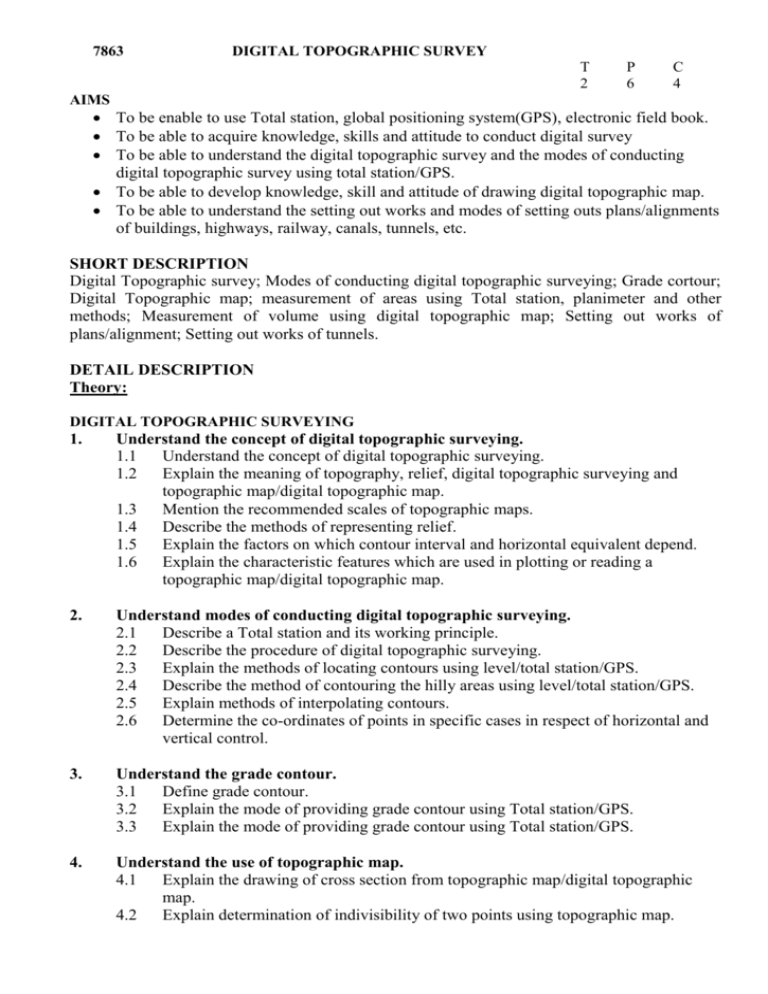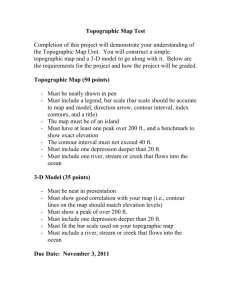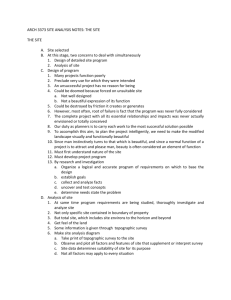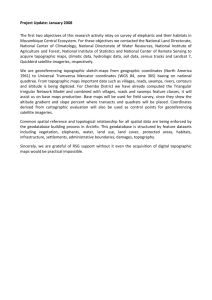Digital Topographic Surveying
advertisement

7863 DIGITAL TOPOGRAPHIC SURVEY T 2 P 6 C 4 AIMS To be enable to use Total station, global positioning system(GPS), electronic field book. To be able to acquire knowledge, skills and attitude to conduct digital survey To be able to understand the digital topographic survey and the modes of conducting digital topographic survey using total station/GPS. To be able to develop knowledge, skill and attitude of drawing digital topographic map. To be able to understand the setting out works and modes of setting outs plans/alignments of buildings, highways, railway, canals, tunnels, etc. SHORT DESCRIPTION Digital Topographic survey; Modes of conducting digital topographic surveying; Grade cortour; Digital Topographic map; measurement of areas using Total station, planimeter and other methods; Measurement of volume using digital topographic map; Setting out works of plans/alignment; Setting out works of tunnels. DETAIL DESCRIPTION Theory: DIGITAL TOPOGRAPHIC SURVEYING 1. Understand the concept of digital topographic surveying. 1.1 Understand the concept of digital topographic surveying. 1.2 Explain the meaning of topography, relief, digital topographic surveying and topographic map/digital topographic map. 1.3 Mention the recommended scales of topographic maps. 1.4 Describe the methods of representing relief. 1.5 Explain the factors on which contour interval and horizontal equivalent depend. 1.6 Explain the characteristic features which are used in plotting or reading a topographic map/digital topographic map. 2. Understand modes of conducting digital topographic surveying. 2.1 Describe a Total station and its working principle. 2.2 Describe the procedure of digital topographic surveying. 2.3 Explain the methods of locating contours using level/total station/GPS. 2.4 Describe the method of contouring the hilly areas using level/total station/GPS. 2.5 Explain methods of interpolating contours. 2.6 Determine the co-ordinates of points in specific cases in respect of horizontal and vertical control. 3. Understand the grade contour. 3.1 Define grade contour. 3.2 Explain the mode of providing grade contour using Total station/GPS. 3.3 Explain the mode of providing grade contour using Total station/GPS. 4. Understand the use of topographic map. 4.1 Explain the drawing of cross section from topographic map/digital topographic map. 4.2 Explain determination of indivisibility of two points using topographic map. 4.3 4.4 4.5 4.6 4.7 4.8 Explain the tracing of contour gradient and location of routes from topographic map. Describe the measurement of drainage areas using topographic map. Describe the calculation of reservoir capacity using topographic map. Explain the surface intersection from topographic map. Explain the measurement of volume from topographic map. Solve problems related to area & volume from topographic map. 5. Understand the measurement of areas using planimeter Total station and other method. 5.1 Describe a planimeter and its use. 5.2 Describe the process of measurement of areas using planimeter. 5.3 Explain the zero circle of a planimeter. 5.4 Explain the multiplying constant of planimeter. 5.5 Describe the process of measurement of areas using Total station/GPS. 5.6 Describe following methods of measurement of areas: a) Computerized methods using digital topographical map. b) Dividing the areas into some triangles. c) Areas from offsets to a base line at regular interval. d) Average ordinate rule. e) Trapezoidal rule. f) Simson’s rule. 5.7 Compare between computerized method and manual method of measurement of areas. 6. Understand the measurement of volumes using topographic map/digital topographic map. 6.1 Explain the measurement of volumes by the following methods: a) Cross-section method. b) Spot leveling method. c) Contour method. d) Computerized methods with the help of Total station/GPS. 6.2 Describe the process of the measurement of volume using Total station/GPS. 6.3 Explain prismoidal correction in determining volumes. 6.4 Explain the correction of curvature. SETTING OUT WORKES 7. Understand the concept of setting out works of plans/alignments. 7.1 Explain setting out works of a plan or an alignment. 7.2 List instruments and accessories required for settingout works. 7.3 Describe the procedure of fixing the center line of a building or a road using Total station/GPS. 7.4 Describe the procedure of giving RL on different parts of the building or road using Total station/GPS. 7.5 Explain settingout works of a building using Total station/GPS. 7.6 Explain settingout works of a culvert Total station/GPS. 7.7 Explain settingout works of a bridge Total station/GPS. 8. Understand the setting out works of tunnels. 8.1 Explain the importance of tunnel construction. 8.2 8.3 8.4 8.5 8.6 8.7 8.8 8.9 Mention different operations of settingout works of tunnel. List the instruments used in tunnel settingout works (including digital survey instruments) Describe settingout works surface alignment using Total station/GPS. Describe settingout works from the ends. Explain transferring alignment underground using Total station/GPS. Explain transferring levels underground using Total station/GPS. Explain settingout underground bench marks using Total station/GPS. Explain importance of accuracy in tunnel surveying. Practical: 1. Conduct topographic survey of a small area and prepare the map using Total station/ GPS. 2. Layout the plans of any building using Total station. 3. Layout the alignment of the following (using Total station/GPS): a) irrigation canal. b) highway/road. c) sewer pipe line. d) underground tunnel. e) vertical alignment of building/tower.






